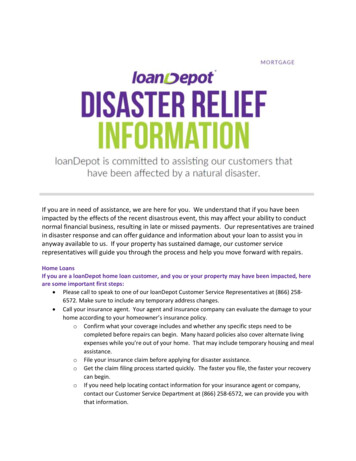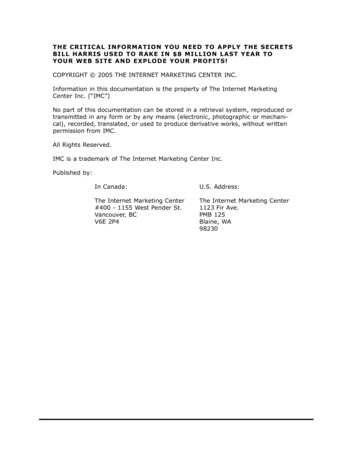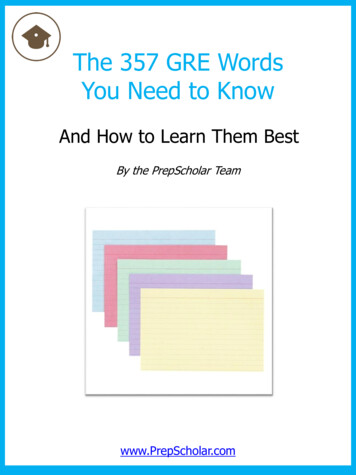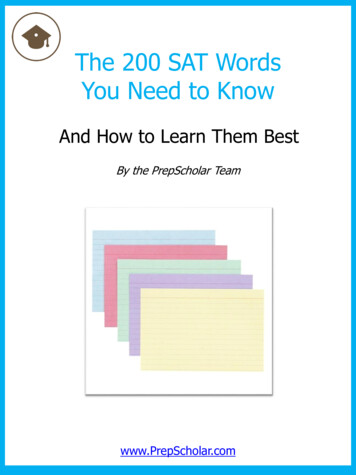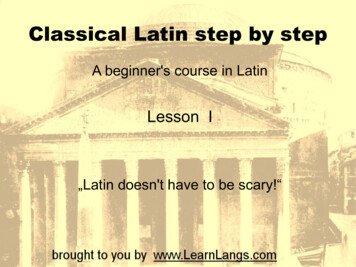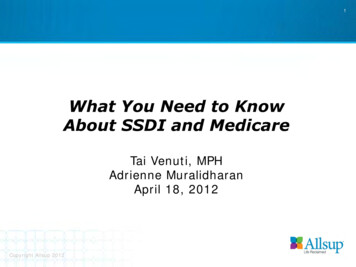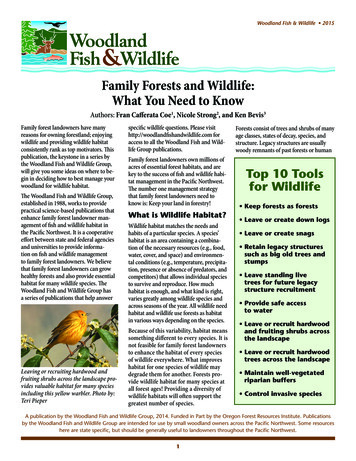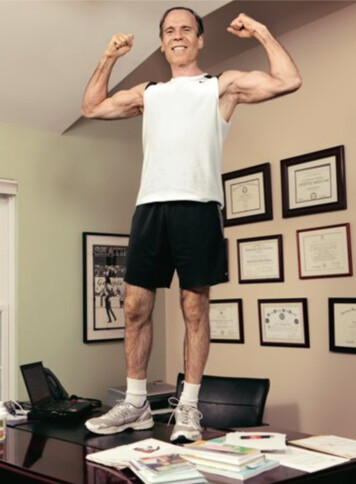
Transcription
THEDOCTORIS OUTTHEREJoel Fuhrman,bestselling author andradical nutritionist (he oncecured a heel injury by fastingfor 46 days), says allyou need to do tolive an optimally healthy,disease-free life iseat pounds and pounds ofvegetables every day.Can you live with that?byMARK ADAMSphotograph byNATHAN PERKELOCTOBER 201287MEN’S JOURNAL
The key scene in a healthand-fitness guru’s biography is almost alwaysthe “Eureka!” momentthat launches him fromobscurity to self-helpsuperstardom. CharlesAtlas was skinny andpoor until he discoveredthe chest- expandingsecrets of Dynamic-Tension. Dr. Robert Atkinswas fat and unhappy until he stumbled acrossthe waist-melting wonders of low-carb eating. Dr. Joel Fuhrman, whose radical ideas onnutrition have made him one of the most influential diet doctors in America today, followed,as he usually does, a different path. Fuhrmanwas already famous as a world-class pairs figureMark Adams is the author of Turn Rightat Machu Picchu. He wrote about ping-ponghustler Marty Reisman in the April 2012 issue.Fuhrman, 20,he says. “And nutrition has thehimself of obesity, osteoarthritis,and his sisterpower to overwhelm genetics.and back pain — saw an opporGale at the1976 Nationals.The medical profession and thetunity for a second act away fromOpposite: Withmasses have absolved themthe ice rink. He earned a mediDr. Oz, whomselves of all responsibility. Theycal degree from the Universityhe knew inthink drugs are the answer toof Pennsylvania, specializingmedical school.everything.”in nutritional medicine, and, inFuhrman isn’t a crunchy1995, published the alt-medicineholistic thinker. He’s a data-analysis guy.manifesto Fasting and Eating for Health. TheHe speaks in a combative tone underscoredbook laid out the unorthodox, roughageby a medium-thick New York accent andheavy rules for maximizing wellness thatsketches little charts and diagrams toFuhrman has since refined and expandedillustrate important points. Fuhrman saysupon for an ever-widening audience. In June,he has reviewed 20,000 journal articles onthe revised edition of his best-known work,nutrition, culling the most important inEat to Live, hit number one on the New Yorkformation from each. Out of this collectedTimes bestseller list.wisdom, tested on thousands of patientsJudging by its cheery, colorful cover,over the years, he has devised a simplewhich promises “Lose 20 Lbs. or More in 6MEN’S JOURNAL88OCTOBER 2012COURTESY DR. JOEL FUHRMANskater, competing on the same amateurcircuit as Dorothy Hamill and other futureOlympic medalists, when, in 1973, at age20, he suffered a life-changing heel injury.“I couldn’t take any impact on it, couldn’tjump and land on it,” Fuhrman says. “Icouldn’t walk for almost a year.” We’re seatedin his offices in a bland corporate park inexurban New Jersey, a suite that looks morelike someplace to sign papers for a mortgagerefinancing than the global headquarters ofa health revolution. At 58, Fuhrman is still inexcellent shape, a point that he illustrates bypausing midsentence to lift his shirt, f lashhis well-defined abs, and frog-jump up anddown off his desk, an apple in each hand.His default facial expression is a smirk thatimplies he possesses an important secret,which he may. With a little more hair, hecould pass for 15 years younger.When the U.S. Olympic Committee’sorthopedist urged Fuhrman to undergoan experimental surgical procedure for hisheel, Fuhrman refused. He sought treatment instead from Herbert Shelton, a SanAntonio naturopath who specialized in irregular cures. Fuhrman, a fit 150 pounds,was put on a regimen of only water for 46days. “They nearly killed me,” he says. “Ifasted down to 88 pounds.” His heel troublevanished, but so did most of his muscle, andhe was unable to regain top form in time forthe 1976 Olympics.A less-farsighted man might have suedShelton for malpractice. Fuhrman — who’dwatched his father use natural methods to ridWeeks” and bears a ringing endorsementfrom celebrity physician Dr. Mehmet Oz(“A medical breakthrough. . . . There is noquestion in my mind that it will work foryou”), Eat to Live ought to be a typical dietbook. A reader who cracks it open expecting WebMD-style advice about countingcalories and taking the stairs more oftenmight be surprised to learn that the authorpreaches something closer to fruitarianismor Christian Science than to conventionalmedical wisdom. In Fuhrman’s world, thenumber of calories one consumes is farless important than the types of food he orshe ingests. Low-carb, high-protein dietsare not only unhealthy, but they will alsoalmost certainly hasten one’s death froman unpleasant disease. Olive oil shouldbe avoided, and the Mediterranean diet ispractically a sham. A slow metabolism ispreferable to a fast one. “Why would youwant to speed up your metabolic rate?” heasked me, throwing his hands up in disbelief. “You’re aging yourself!”Fuhrman’s number-one predictor ofwhether someone will get cancer isn’t family history; it’s what that person puts in hismouth. “Your genes play a very small role,”
formula: H N/C, or health equals nutrition divided by calories. It is the foundationof Fuhrman’s proprietary eating system,which he calls nutritarianism. One of thecore tenets of nutritarianism is that everyone should eat at least one pound of rawvegetables and another pound of cookedones each day, the equivalent of a throwpillow-size bag of spinach and a very largebowl of steamed broccoli. Follow his advice,Fuhrman promises, and you should stayhealthy until at least the age of 95.U T R I TA R I A N I S M ispart of a growing schoolof research-based dietarythinking that insists that,in terms of wellness, youreally are what you eat.Call it plant-based libertarianism. The U.S.has the world’s highest healthcare costs — 2.7 trillion in 2011 — while consistentlyscoring lowest among developed nationsfor quality of care. Practitioners of plantbased libertarianism believe that every person needs to take full responsibility for hisor her own health. This means adopting awellness-focused diet, mostly vegan.Comprehensive improvements in diethave long been shown to reverse, slow, or prevent what are called “diseases of affluence,”largely self-inf licted maladies like obesity,coronary heart disease, stroke, and type 2diabetes. More recent research suggeststhat such dietary improvements also combat Alzheimer’s and cancer. This movementshares some of the life-extension dogma ofthe calorie-restriction crowd and a littleof the anti-agribusiness, eat-local moralismof writers like Michael Pollan (The Omnivore’sDilemma) and films like Food, Inc. Its primary concern, however, is wresting controlof America’s health back from the insuranceand drug companies and returning it to thehands of citizens. As Fuhrman puts it in Eatto Live, “only you, not your physician, musttake responsibility.”“In the future, it’s goingto become more and moreimpossible for the economy to support how expensive medical care is andthe number of sick peoplewe have,” Fuhrman says.“Why don’t we just get ourpopulation healthier so wedon’t need medical care?”Along with Fuhrman,the leaders of plant-basedlibertarianism includenut r it ion i s t T. C ol i nCampbell, co-author ofThe China Study, and hisc om r a de -i n-a r m s Dr.Caldwell Esselstyn, a cardiovascular surgeon. Lastyear, Campbell and Esselstyn starred in thehit documentary Forks Over Knives — the titlereflects a preference for dietary interventionover the surgical variety — and published abestselling book of the same name. Perhapsthe biggest brand name in the field is Dr.Dean Ornish, whose near-vegan diet helpedBill Clinton drop 24 pounds following a second coronary surgery. Fuhrman is somethingof an outlier among this group in that heargues that small amounts of fish, eggs, andlow-fat dairy are permissible so long as a person cranks up the rest of his diet to meet theultrahigh nutritional benchmarks set by theH N/C standard. “The right raw materialscan . . . double or triple the protective powerof the immune system,” he writes in his latestbook, Super Immunity: The Essential Nutrition Guide for Boosting Your Body’s Defensesto Live Longer, Stronger, and Disease Free.The nutrients that most interest Fuhrmanaren’t found in supplements or multivitamins.He focuses instead on the immunity-boostingpower of micronutrients. These include antioxidants and phytochemicals, which he calls“the most important discovery in humannutrition in the last 50 years,” though mostof them have yet to be named or even iden-tified. The foods highest in micronutrientsper calorie are unprocessed plant foods,mostly fruits and vegetables, which makeup 90 percent of an ideal nutritarian diet.In Fuhrman’s system, calorie-dense olive oil(nine points) scores lower than white bread(18 points) because its phytochemical loadis so low relative to its fat content.“If you want ideal health, you need toovercompensate and eat an excellent diet,”Fuhrman says. He estimates that if all Americans were to adopt a nutritarian diet, “theimmediate impact is that cancer rates mightdecrease by half. But the long-term impact,over generations. . . .” He picks up a penciland draws a downward-sloping line. “If weget kids eating right, we could decrease cancer rates by 90 percent.”Like most evangelists, he maintains fewbarriers between his professional and personal life. At least one patient recalls arriving for an initial consultation and receivingan invitation for her family to swim at theFuhrman home in New Jersey later that day.Fuhrman’s wife, Lisa (age 53; looks a very fit40), manages his online business and co-starsin his cooking DVD. The four Fuhrman children, ages 10 to 24, (continued on page 115)THE FUHRMAN PLAN: HOW TO EAT TO LIVEđƫ !ƫ .*!./0 *!ƫ "ƫ 1 .) *Ě/ƫEat to Liveƫ,( *ƫ%/ƫ ƫ/%4ġ3!!'ƫ/0 .0!.ƫ, /!ƫ1.%*#ƫ3 % ƫ ƫ,!./ *ƫ ,0/ƫ %/ƫ*10.%0 .% *ƫ %!0ċƫ !ƫü./0ƫ) *0 Čƫ 1 .) *ƫ,. )%/!/Čƫ0 !ƫ 2!. #!ƫ,!./ *ƫ3%((ƫ( /!ƫāĆƫ, 1* /ƫ 5ƫ!4,1*#%*#ƫ %/ƫ %!0ƫ "ƫ *%) (ƫ,. 1 0/ƫĨ%* (1 %*#ƫ %.5ĩČƫ %(/Čƫ ! ƫ/ (0Čƫû!%*!Čƫ".1%0ƫ&1% !/Čƫ ( (Čƫ, 0 0 !/Čƫ * ƫ ((ƫ.!ü*! ƫ. 5 . 0!/ċƫ *!ƫ0 ƫ03 ƫ/!.2%*#/ƫ "ƫ!##ƫ .ƫü/ ƫ,!.ƫ3!!'ƫ .!ƫ (( 3! Čƫ,. 2% ! ƫ* ƫ) .!ƫ0 *ƫāĀƫ,!. !*0ƫ "ƫ( .%!/ƫ )!ƫ". )ƫ,. 0!%*ċƫĨ *ƫ ƫ,!.ġ ( .%!ƫ /%/Čƫ 1 .) *ƫ/ 5/Čƫ . (%ƫ /ƫ 1 (!ƫ0 !ƫ,. 0!%*ƫ "ƫ/0! 'ċĩƫ 1ƫ .!ƫ,!.)%00! ƫ0 ƫ! 0ƫ/ƫ) *5ƫ2!#!0 (!/Čƫ".!/ ƫ".1%0/Čƫ * ƫ ! */ƫ /ƫ !/%.! ċƫ 2!.! 0%*#Čƫ 1 .) *ƫ/ 5/Čƫ.!/1(0/ƫ". )ƫ, .ƫ! 0%*#ƫ %0/Čƫ3 % ƫ(! 2!ƫ0 !ƫ 5ƫ/0 .2! ƫ" .ƫ*10.%!*0/ċƫė ),(!0!(5ƫ.!0 %*'ƫ5 1.ƫ% ! ƫ "ƫ3 0ƫ ƫ, .0% *ƫ%/čƫ '!ƫ%0ƫ 1#!ČĘƫ !ƫ3.%0!/ċƫ 0ƫ)! */ƫ0ƫ(! /0ƫ *!ƫ, 1* ƫ "ƫ. 3ƫ2!#!0 (!/ƫ ƫ 5Čƫ,(1/ƫ ƫ, 1* ƫ "ƫ '! Ďƫ" 1.ƫ".!/ ƫ".1%0/Ďƫ * ƫ ƫ 1,ƫ "ƫ ! */ċƫ%)%0! ƫ ) 1*0/ƫ "ƫ. 3ƫ*10/Čƫ/!! /Čƫ3 (!ƫ#. %*/Čƫ * ƫ2 ƫ .!ƫ (( 3! ċƫ ƫ( .%!ƫ 1*0%*#ƫ%/ƫ.!-1%.! ċƫ ƫ/* '/ƫ .!ƫ,!.)%00! ċCOURTESY DR. OZ SHOW/NBCTHEREGIMENđƫ 0ƫ *ƫ ƫ 1 %*#ƫ*10.%0 .% *ƫ!4,! 0ƫ%*ƫ.!01.*ƫ" .ƫ0 !/!ƫ(%"!/05(!ƫ *#!/ĕƫ 1 .) *ƫ,. )%/!/ƫ%),. 2! ƫ/(!!,Čƫ%* .! /! ƫ%))1*%05Čƫ * ƫ) .!ƫ!*!.#5ċƫ %*!05ƫ,!. !*0ƫ "ƫ05,!ƫĂƫ % !0!/ƫ, 0%!*0/ƫ *ƫ(! 2!ƫ%*/1(%*ƫ3%0 %*ƫ ƫ) *0 Čƫ !ƫ/ 5/ĎƫĉĀƫ,!. !*0ƫ "ƫ ! ġ !ƫ/1û!.!./ƫģƫ%* (1 %*#ƫ0 /!ƫ3%0 ƫ)%#. %*!/ƫģƫ.! 2!.ƫ3%0 10ƫ)! % 0% *ċƫ !ƫ,.% !ƫ "ƫ )%//% *ƫ0 ƫ0 %/ƫ* 01. (ġ ! (0 ƫ*%.2 * ƫ%/ƫ/!2!. (ƫ 5/ƫ "ƫ)%( ƫ %/ )" .0ƫĨ ! !/Čƫ(%# 0ġ ! ! *!//Čƫ 1*#!.ĩƫ /ƫ0 !ƫ 5ƫ !0 4%ü!/ƫ". )ƫ%0/ƫ %0ƫ "ƫ%* 1(#%*#ƫ!2!.5ƫ . 2%*#ƫ3%0 ƫ" ċTHEBENEFITSOCTOBER 201289đƫ ƫ0!/0! ƫ 1 .) *Ě/ƫ% ! /ƫ" .ƫ/%4ƫ3!!'/Čƫ0 1# ƫ ƫ % ƫ(( 3ƫ)5/!("ƫ ƫ/) ((ƫ 1,ƫ "ƫ( 'ƫ û!!ċƫ 5ƫ !0 4ƫ, /!ƫ( /0! ƫ 10ƫ" 1.ƫ 5/ƫ * ƫ3 /*Ě0ƫ!/,! % ((5ƫ1*,(! / *0Ďƫ*5ƫ 1*#!.ƫ, *#/ƫ ƫ ƫ 1( ƫ !ƫ 2 % ! ƫ3%0 ƫ,1* 3(ġ/%6!ƫ, .0% */ƫ "ƫ(! "5ƫ#.!!*/ċƫ "0!.ƫ ƫ 1,(!ƫ "ƫ3!!'/Čƫ)5ƫ/'%*ƫ3 /ƫ(! .!.ƫ * ƫ"!(0ƫ) .!ƫ/1,,(!ċƫ ƫ/(!,0ƫ ƫ(%00(!ƫ !00!.ƫ10ƫ % *Ě0ƫ"!!(ƫ *5ƫ ) 6%*#ƫ/1.#!ƫ "ƫ)!*0 (ƫ!*!.#5ċƫ ƫ% *Ě0ƫ 0 ƫ ( /ƫ0 0ƫ)5ƫ %( .!*ƫ . 1# 0ƫ )!Čƫ * ƫ0 !ƫ/0 ) ƫ 1#ƫ0 0ƫ ƫ,!/0!.! ƫ)!ƫ" .ƫ) *0 /ƫ2 *%/ ! ċƫ 5ƫ ( ƫ,.!//1.!ƫ. ,,! Čƫ)5ƫ, 5/% (ƫMEN’S JOURNAL/0 )%* ƫ%),. 2! Čƫ * ƫ)5ƫ,!./ * (ƫ0. %*!.ƫ % *Ě0ƫ* 0% !ƫ*5ƫ %,ƫ%*ƫ/0.!*#0 Čƫ !/,%0!ƫ)5ƫ2 0% *ƫ". )ƫ *%) (ƫ,. 0!%*ċƫ ƫ( /0ƫ 10ƫ*%*!ƫ, 1* /ƫ * ƫ03 ƫ%* !/ƫ". )ƫ)5ƫ3 %/0ċƫ *" .01* 0!(5Čƫ3 %(!ƫ 1 .) *ƫ%*/%/0/ƫ0 0ƫ *!Ě/ƫ, ( 0!ƫ ,0/ƫ0 ƫ0 !ƫ* *,%-1 *0ƫ,(! /1.!/ƫ "ƫ*10.%0 .% *ƫ 1%/%*!Čƫ)%*!ƫ3 /ƫ ƫ ( 10ċƫ 3% !Čƫ ƫ 3 '!ƫ 0ƫ*%# 0ƫ *2%* ! ƫ Ě ƫ .! )! ƫ "ƫ0 !ƫ3 .( Ě/ƫ) /0ƫ !(% % 1/ƫ" ċƫ !ƫ0 %. ƫ0%)!Čƫ ƫ& 00! ƫ%0ƫ 3*ċƫ *ƫ0 !ƫ) .*%*#Čƫ0 !ƫ0 ƫ !(% 5ƫ 1*0%*#ƫ)5ƫ/1 */ % 1/ƫ3 /ƫ.!2! (! ƫ%*ƫ)5ƫ * 3.%0%*#čƫMustard.ƫģ ċ ċTHERESULTS
JOEL FUHRMAN continued from page 89have been raised on a plant-based diet butare allowed to make their own food choicesoutside the home. According to their father,they almost always stick with the program:“One of my daughters once joked that for her,a cookie would be like shooting up heroinor smoking pot.” Fuhrman often cites hischildren as examples of the benefits of nutritarianism — he cannot recall a single ear infection or case of the flu among them. Unlikemost family practitioners, Fuhrman gleefullypicks fights with other doctors, particularlythose whose diets he disagrees with. “TheDukan Diet, the one Kate Middleton wason? That’s the stupidest diet in the world,”he says, scoffing at the high-protein plan.The competitive f ire that once droveFuhrman as a skater is now largely channeled into marketing. Drfuhrman.com offersfree nutritarian eating plans, with consultations, for overweight brides-to-be who wishto lose 50 or more pounds by their weddingday and are willing to provide a testimonialonline “and possibly in magazines and ontelevision.” Fuhrman’s “3 Steps to Incredible Health” special — essentially a stylishinfomercial for nutritarianism — has become a staple during the self-improvementbloc of PBS pledge drives. As an author,Fuhrman has one distinct advantage overvirtually all his neighbors in the diet-bookaisle at Barnes & Noble: He is an entertainingwriter with a gift for plucking fascinatingfacts and figures out of dry journal articles.(Two random examples: Three servings ofcruciferous vegetables per week lower therisk of prostate cancer by 41 percent. Linebackers are six times as likely as enduranceathletes to die young.)If you’ve set foot in a Whole Foods, youmay have noticed that the fruits, vegetables,and dairy products are labeled with an ANDI(Aggregate Nutrient Density Index) score, anumber calculated with Fuhrman’s H N/Cformula. (Leafy greens, like kale, low in calories and packed with phytochemicals, scorea perfect 1,000.) “In my 31 years at WholeFoods, these scores are one of the biggest successes we’ve had,” says Margaret Wittenberg,the company’s global VP of quality standardsand public affairs. “There’s times we’ve hadstores run out of kale.” Fuhrman also recommends large quantities of onions, garlic, berries, and mushrooms, all of which he creditswith anticancer properties. “Women who atemushrooms in China had a 64 percent lowerincidence of breast cancer,” he says, citing arecent study. “That should’ve been on thefront page of the New York Times.”Micronutrients, Fuhrman contends, arealso one of the unacknowledged keys to understanding the American obesity epidemic.Americans get less than five percent of theircalories from unprocessed fruits and vegetables that aren’t white potatoes; 62 percentof our calories comes from nutrient-poorprocessed foods that are usually loaded withcarbohydrates. Fuhrman believes that weovereat these foods not only for the dopamine rush they supply but also in a futile attempt to make up for a micronutrient deficit.The more junk we consume, the more toxins,like free radicals, amass in our tissues. “Webecome addicted to this toxicity builduplike it was cocaine or nicotine,” Fuhrmansays. “When we try to stop eating, we getwithdrawal symptoms.” These include thegnawing sensation in the stomach, irritability, and light-headedness that 99.9 percentof us would identify as hunger.Fuhrman says these pangs are fakesignals, an overriding of natural appetitethat should kick in only once the body hasexhausted its glycogen stores. The notunpleasant sensation he calls “true hunger”is felt in the throat, neck, and mouth ratherthan the belly. It can be satiated by consuming almost any healthy food. Any urge thatmight qualify as a craving is, by Fuhrman’sdefinition, a sign of food addiction.THE IDEA THAT a restrictive diet mighthold the antidote for all modern ills isn’t new.In a famous 1939 study conducted by theRockefeller Institute, a thousand rats werefed a diet equivalent to that of the averageAmerican. The rodents developed 39 different diseases of aff luence akin to those seenin the human populace. Another thousandrats were fed a calorie-restricted, raw-fooddiet modeled on the ascetic customs of a longlived tribe in the Himalayas. Not one rat inthe second group became sick in two and ahalf years. That story actually did make thefront page of the New York Times.Yet our faith that science will develop apill or procedure to cure whatever ails usis unshakable. Since the Human GenomeProject began spilling the secrets of DNAa decade ago, many of our hopes have beentied to the potential discovery of particulargenes linked to specific disorders that, oncedecoded, will offer road maps for doctorsand drug researchers to follow. But the potential of gene therapy as a cure for cancerremains limited. One comprehensive reviewof cancer-prevention research estimated thatonly five to 10 percent of cancers resultedfrom inherited gene defects. The same studyfound that 30 to 35 percent of cancer deathsare “linked to diet,” with an additional 10 to20 percent linked to obesity. Prostate cancers had a 75 percent dietary cause.“We know that cancer is a preventabledisease that requires changing lifestyle,” saysBharat Aggarwal, a professor of experimental therapeutics at the M.D. Anderson CancerCenter in Houston. “No matter which cancer you pick, they’ve (continued on page 117)
JOEL FUHRMAN continued from page 115found out at least 200 to 500 genes have gonewrong. That means 200 to 500 pathways.The drug industry knows how to target onlyone pathway at a time. Natural products hitmultiple pathways, so they slow down theprogression of the disease.”Fuhrman is flabbergasted at the amountof money going into cancer-cure research.“We’re not going to find a magic cure forcancer,” he says. “We’ve got to prevent it.”Micronutrients, in his opinion, are “thefuel that turns on our body’s anticancerdefenses.” Animal protein, on the otherhand, raises levels of IGF-1, a hormone thatstimulates growth in children but promotestumor development in adults. Dr. Luigi Fontana, who conducted a multiyear study onlong-term calorie restriction, observed a correlation between protein consumption andIGF-1 levels. “There’s a perception that youcan eat as much protein as you want,” Fontana says, “and it’s safe and healthy. Our datasuggests that probably this is not correct.”With each book, Fuhrman has pushedthe possibilities of nutritarianism a littlefurther. A banner running across the bottom of Super Immunity’s cover promises, incapital letters: no shots – no drugs – nosick days. Fuhrman writes that “healthypeople eating healthy food should neverneed to take an antibiotic.” In his off ice,he dials that claim back a little, saying thatantibiotics might be necessary on “very rareoccasions.” I ask for examples.“Certainly, you could step on a sea urchin,” he says. “You could get bitten by a cat.”Viruses, Fuhrman says, are relativelyharmless in a healthy person; a bug that killsone person might not even cause symptomsin a committed nutritarian. Because Americans are hooked on immunity-depressing“fast food and sugar and junk,” we aren’tprepared for the kind of viral pandemic suchas the 1918 Spanish flu, which killed at least50 million people worldwide. “Some sort ofswine f lu/bird f lu hybrid could kill 20 percent of our population,” Fuhrman says. As forthe annual flu shot, “it isn’t effective at all — itdoesn’t work!” He’s also skeptical about thenumber of vaccines the average Americanchild receives. “There’s no chance of anyonegetting polio in this country,” he says.ON A CHILLY FRIDAY night in Princeton,New Jersey, more than 300 people who havepaid 800 and up for one of Fuhrman’sWeekend Immersions have arrived at theHyatt Regency. The event is sold out, and aspacious ballroom that has seen its share ofrented tuxes and bridesmaid dresses is filledwith an odd cross-section of the Fuhrmanfaithful and curious newcomers. Ectomorphic women with yoga arms wander aimlessly between the tables as if searching fortheir mislaid kombucha. Wide men withrolls of fat bulging from the back of theirnecks sit with their arms folded, their grimfacial expressions hinting at recent bad newsfrom their cardiologists.I found a seat next to a slim fellow namedRob Alexander-Carew, who’d f lown downfrom Toronto. He’d been following a nutritarian program for four months. “I’ve lost30 pounds,” he told me. “I’m the same sizeI was when I was 15.” He started eating nutritarian in hopes of finding relief for hispulmonary fibrosis, a scarring of the lungswith no known cause or cure. Though helooked like a cross-country runner, Rob wasdown to 60 percent lung capacity.“Do you feel like it’s working?” I asked.“I’m lighter and f itter. My kids comehome with a cold and I catch it, but 12 hourslater it’s gone, and I’m like, what just happened? But my lungs haven’t opened up yet.”I noticed that Rob was picking at his nutritarian dinner — steamed kale in creamycashew sauce.“Any foods you miss?” I asked him.“Bread,” he said, stirring his vegetablesoup. “I really miss bread.”Fuhrman took the stage, flanked by slender acolytes dressed in black. He gave a shortspeech, exhorted the audience to “Changeyour life!” — and was followed by testimonials from patients relating the miraculouschanges they’d seen under his care. One hadovercome rheumatoid arthritis; another hadlost 144 pounds. A children’s book authorwith stage-four ovarian cancer had eatenher way back to health.All this sounded completely plausibleto me. I had followed Dr. Fuhrman’s Eat toLive plan for six weeks, and the results wereundeniable. But it’s hard to be perfect all thetime, even if the payoff is near-eternal health.I don’t know how many people who aren’tfacing imminent death — or who wouldn’t becapable of living on water for 46 days to curea heel injury — would have the willpower tostick with nutritarianism forever. When itcomes to the link between diet and health,Americans not only expect to have our cakeand eat it, too, but we also insist that our doctors prescribe something to undo the consequences of our gluttony. In the months aftermeeting Fuhrman, as I tried to weave some ofhis dietary precepts into my life, the secondbiggest story in health news was First LadyMichelle Obama’s inexplicably controversialinitiative to encourage kids to exercise andeat more vegetables. The biggest health-newsstory was that the FDA had granted preliminary approval to a new anti-obesity drug.Fuhrman puts forth a convincing casethat by making some fundamental dietarychanges — sacrifices, really — Americanscan live longer, healthier lives. The questionis, can we live with that? MJ INTRODUCING THE COMPETITION-BEATING* EAGLE F1 ASYMMETRIC ALL-SEASON.RACE-INSPIRED DESIGN MEETS ALL-SEASON CONTROL. WATCH OUR UNDERCOVER STUNT DRIVER SHOW REAL PEOPLE HOW THE NEWEAGLE F1 HANDLES IN RAIN AND SNOW, AND EVEN HANDLES A FEW SURPRISES ON OUR TEST COURSE AT GOODYEAR.COM/CONTROLFREAK.*Based upon Goodyear internal wet-handling test on 225/45R17 tire versus Michelin Pilot Sport A/S plus. 2012 The Goodyear Tire & Rubber Company. All rights reserved.
year, Campbell and Esselstyn starred in the hit documentary Forks Over Knives — the title reflects a preference for dietary intervention over the surgical variety — and published a bestselling book of the same name. Perhaps the biggest brand name in the field is Dr. D
